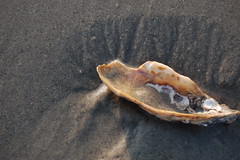There is beauty in strange places. An ordinary life can leave traces of us that gather into something oddly appealing. Something more than the sum of its parts.
Those of you who live near the sea understand the compulsion to collect shells. They add a little something to our homes and gardens. Most end up in dishes in the bathroom. This could just reflect the color scheme and shouldn't be taken too personally by the relegated object. As well as beautiful debris, shells also played an embalming role as they collect in shell middens from coastal communities. These piles of discarded shells, now garbage, hold interest for those who study archaeology, a term used since garbology didn't sound as scientific. Having food “packaging” accumulate in vast heaps around towns and villages is hardly a modern phenomenon.
Many First Nations sites were inhabited continually for centuries. The discarded shells and scraps of bone from their food formed enormous mounds called middens. Left over time, these unwanted dinner scraps can transform through a quiet process of preservation.
Time and pressure leach the calcium carbonate, CaCO3, from the surrounding marine shells and help “embalm” bone and antler artifacts that would otherwise decay. Calcium carbonate is a chemical compound that shares the typical properties of other carbonates.
CaCO3 is common in rocks and shells and is a useful antacid for those of you with touchy stomachs. In prepping fossil specimens embedded in limestone, it is useful to know that it reacts with stronger acids, releasing carbon dioxide: CaCO3(s) + 2HCl(aq) → CaCl2(aq) + CO2(g) + H2O(l)
It also releases carbon dioxide on heating (to greather than 840 °C in the case of CaCO3), to form calcium oxide or quicklime, with reaction enthalpy 178 kJ / mole: CaCO3 → CaO + CO2
Calcium carbonate will react with water that is saturated with carbon dioxide to form the soluble calcium bicarbonate: CaCO3 + CO2 + H2O → Ca(HCO3)2
Bone already contains calcium carbonate, as well as calcium phosphate, Ca2, but it is also made of protein, cells and living tissue. Decaying bone acts as a sort of natural sponge that wicks in the calcium carbonate displaced from the shells. As protein decays inside the bone, it is replaced by the incoming calcium carbonate, making makes the bone harder and more durable.
The shells, exquisite in their own right, make the surrounding soil more alkaline, helping to preserve the bone and turning the dinner scraps into beautiful scientific specimens for future generations.



